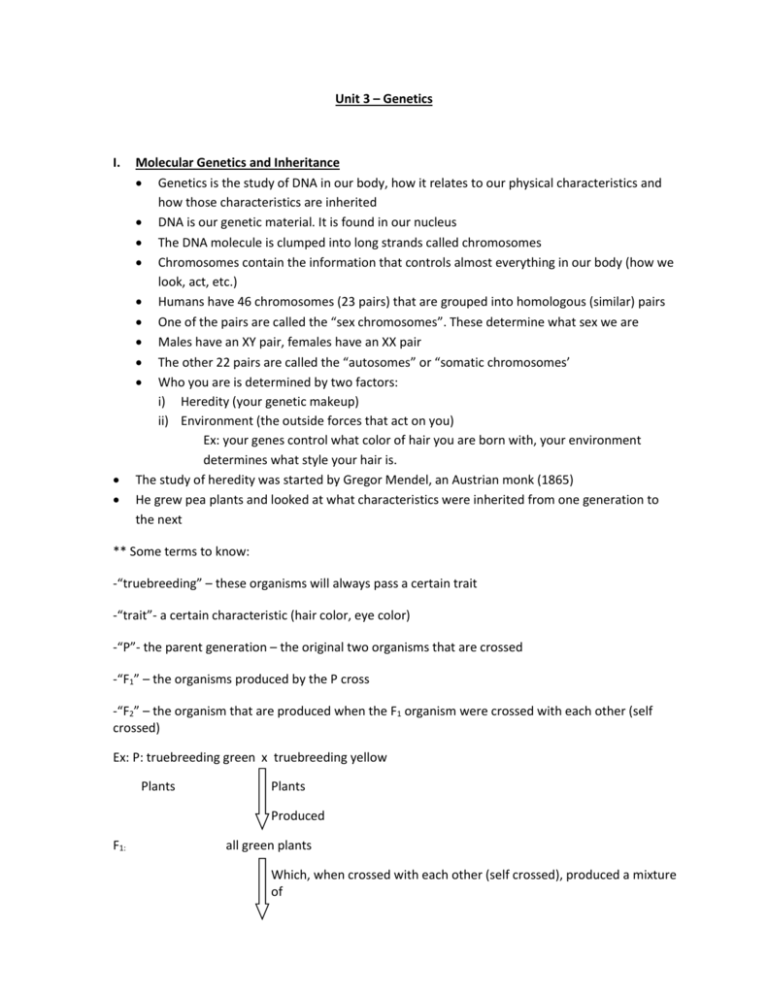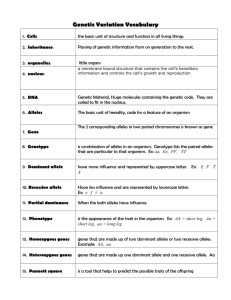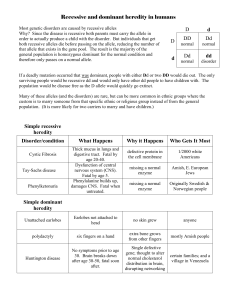Genetics - FW Johnson Collegiate
advertisement

Unit 3 – Genetics I. Molecular Genetics and Inheritance Genetics is the study of DNA in our body, how it relates to our physical characteristics and how those characteristics are inherited DNA is our genetic material. It is found in our nucleus The DNA molecule is clumped into long strands called chromosomes Chromosomes contain the information that controls almost everything in our body (how we look, act, etc.) Humans have 46 chromosomes (23 pairs) that are grouped into homologous (similar) pairs One of the pairs are called the “sex chromosomes”. These determine what sex we are Males have an XY pair, females have an XX pair The other 22 pairs are called the “autosomes” or “somatic chromosomes’ Who you are is determined by two factors: i) Heredity (your genetic makeup) ii) Environment (the outside forces that act on you) Ex: your genes control what color of hair you are born with, your environment determines what style your hair is. The study of heredity was started by Gregor Mendel, an Austrian monk (1865) He grew pea plants and looked at what characteristics were inherited from one generation to the next ** Some terms to know: -“truebreeding” – these organisms will always pass a certain trait -“trait”- a certain characteristic (hair color, eye color) -“P”- the parent generation – the original two organisms that are crossed -“F1” – the organisms produced by the P cross -“F2” – the organism that are produced when the F1 organism were crossed with each other (self crossed) Ex: P: truebreeding green x truebreeding yellow Plants Plants Produced F1: all green plants Which, when crossed with each other (self crossed), produced a mixture of F2 3 green plants : 1 yellow plant Mendel’s Explanation Something in the plant controlled the traits. He called these “factors” The F1 plants weren’t pure. They carried a mix of factors from the parents. The factor for green was dominant (it was seen), the yellow factor was recessive (it wasn’t seen) When the F1 plants were self crossed, the factors were combined. Yellow plants are produced if there are no dominant factors present We now know that each parent passes on half of their genetic information to their offspring during reproduction Males produce sperm, females produce eggs. These are known as “gametes”. There are areas on chromosomes called “genes” Genes are specific sequences of DNA that control a physical characteristic Ex: genes control eye color, height, skin color Genes can come in different forms called “alleles” Ex: gene for eye color has a blue allele, a brown allele, a green allele, etc The genetic makeup of an organism (what genes it has on its chromosomes is called its “genotype” The organism will have two alleles for each gene it is genotype (one from each parent). Each allele if found on one of the homologous chromosomes If the alleles are the same, they are “homozygous” (truebreeding) If the alleles are different they are “heterozygous” The physical appearance of an organism is its “phenotype” Alleles can be dominant or recessive. In a heterozygous pair of alleles, the dominant allele will mask the recessive allele. Only the dominant trait will be expressed (be shown) in the phenotype *Dominant alleles are given capitol letters *Recessive alleles are given lowercase letters Ex: Brown eyes – B Keep the same letter because they’re alleles of the same gene Grey eyes – b Phenotype Genotype Grey eyes bb(homozygous) Brown eyes BB or Bb Each time an individual produces a gamete, half of the genetic material (one allele from each pair) is passed on Dominant alleles don’t get passed on more than recessive alleles (50/50 chance) Codominance This is the condition where there are two alleles, but neither one is dominant nor recessive In the heterozygous organism, the traits will blend Ex: coat color Turebreeding x Black coat truebreeding white coat Grey coat We assign capitol letters and lowercase letters, but they don’t refer to dominance or recessiveness Black – BB White – bb Grey – Bb – indicates a mixing of the two traits Dihybrid Cross A dihybrid cross is when two different traits are being considered (eye color and hair color) Write down the allele combination that would be passed on by: AABB Qqrr MmTt Ex: in kangaroos, the allele for red fur (R) is dominant over the allele for brown fur (r) and the allele for long tails (L) is dominant over that for short tails (l). Set up the Punnet squares for these crosses: a) RRLL x RrLL Rl rL RL b) rrLl x RrLl RL RRLL RrLL rL c) RrLl x RrLl RL RrLL rl RRLL Rl RrLL RrLl rL rl RrLl rrLL rrLl Rrll rrLl rrll *If 16 offsrping were produced in cross “c”, how many would be expected to have red fur and short tails? RrLl x RrLl RL Rl rL rl RL RRLL RRLl RrLl RrLl Rl RRLl RRll RrLl RRll rL RrLL RrLl rrLL rrLl rl RrLl Rrll rrLl rrll -3 out of 16 will have red fur and short tail. -the third combination, were both parents were heterozygous for both traits produced a 9:3:3:1 ratio: 9 red, long (dominant, dominant) 3 red, short (dominant, recessive) 3 brown, long (recessive, domiant) 1 brown, short (recessive, recessive)








